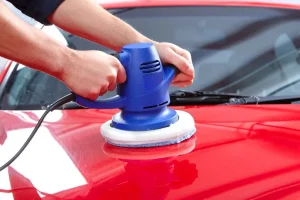Car wax should be an integral component of any vehicle owner’s maintenance routine. It shields paint from harmful UV rays from the sun that cause fading and oxidization, and provides additional protection from bird droppings and tree sap contamination.
Before applying any type of car wax, it is a best practice to wash and clay bar your vehicle to ensure it’s as squeaky clean as possible and free from contamination.
1. Wash Your Car First
Wax helps protect the paint on your car from exposure and maintain its shine, keeping its appearance new and shiny. Always choose high-quality wax recommended by its manufacturer.
Be sure to follow all instructions and guidelines provided by the manufacturer in order to achieve optimal results. Similarly, keep your car out of direct sunlight when applying wax.
Start off by cleaning your car thoroughly and gathering supplies by filling two buckets — one for rinse and the other for wash. Next, use a soft cloth to apply wax in small circles until it dries completely and haze forms over it.
2. Use a Microfiber Cloth
No matter whether you opt for liquid or paste wax, it is vital that you read and follow all directions closely. Work in small sections until all sections have been done and ensure the car remains cool to touch before using a microfiber buffing towel that is machine-washable and reusable multiple times.
These luxurious towels are extremely soft and won’t scratch paint surfaces, while being an effective way to soak up excess wax without leaving streaks behind. However, cotton towels will produce lint that may cause issues in cleaning them properly.
3. Apply the Wax in Small Circles
If you want a high-shine finish, it is necessary to allow the wax to set (or haze) before buffing it off. Please referring to the instructions of the product to make sure this process goes as intended.
As direct sunlight can lead to streaking, it’s also essential that you work in an area with some shade. Finally, working in sections of 2-4 square feet at a time will prevent applying more wax than necessary and also make removal simpler without creating scratches in your surfaces.
4. Let It Dry
Wax should always be applied thinly; be it by hand or buffer. Overly thick coatings of wax waste product and lengthen drying processes while making removal difficult later on.
Allow the wax to set into a haze for several minutes, before buffing it away with a clean microfiber towel. As needed, fold over to ensure it dries on one side only and avoid reapplying wax.
Waxing your car on a cloudy or rainy day, or inside of a garage, will prevent the sun from melting the wax too quickly and baking the paint job.
5. Buff It Off
Car enthusiasts know the thrill of making their old jalopy look as good as new. Waxing it makes your car shine and protects it against environmental hazards like bird droppings, tree sap and etching.
As soon as you start out, make sure that you have all of the supplies needed, such as a power buffer and microfiber cloths. Furthermore, find an shady spot to park your car so the wax can warm up a bit so it will be easier for you to buff out perfectly.
6. Don’t Overwork the Paint
Waxing is essential to keeping any car looking brand new for years and years, whether you own an expensive sports car or a grocery-getter. Wax protects paint against airborne contaminants while filling small scratches to keep its look brand new for many years to come.
Be sure to work in a cool location away from direct sunlight when applying liquid or paste wax. Working in small sections at once such as half the hood helps you control coverage; applying thin coats of wax dries faster and can be removed more easily than thicker coats.
7. Keep it Clean
Ethos Ceramic Wax PRO can provide superior results by resisting water spots and offering a brilliant sheen, so to make the job simpler use a clean, cool place when applying wax to avoid direct sunlight and use an applicator pad sparingly to control coverage.
After washing your car, it is crucial to use microfiber towels and thoroughly rinse and dry off its exterior surfaces with fresh water before applying wax or using clay bars to eliminate contaminants.
8. Don’t Overspray
Before beginning waxing your car, ensure it’s both clean and dry. Furthermore, try to avoid direct sunlight as direct heat could cause the wax to heat up and slip off of its basecoat.
Car waxing gives your car an elegant sheen while protecting it from UV rays that could otherwise oxidize its paintwork. Waxing also repels water and dirt accumulations for easier washing. To apply wax, work in small sections while polishing it off using a microfiber cloth after each section is complete.
9. Don’t Overwork the Tires
Car waxes provide your vehicle’s paint with additional protection while leaving its surface looking glossy and smooth. Plus, their application doesn’t require special tools or skills!
Carnauba and synthetic are the two primary car wax types available today, respectively. While carnauba wax provides superior shine, synthetic wax is less costly and easier to apply but doesn’t provide as much protection. When applying synthetic wax it should be done so in small circles using a clean microfiber cloth and should never be exposed directly to sunlight or heat sources.
10. Don’t Wait Too Long
Car wax provides your vehicle with protection from environmental contaminants like UV rays, dirt, bird droppings, and acid rain while adding a rich, glossy shine to its finish. There are natural options such as carnauba waxes or synthetic products available.
Avoid procrastinating too long between waxing sessions as car wax can dry out quickly. To prevent this from happening, apply wax in sections under shaded conditions and work quickly before buffing it off before the wax hardens completely.
